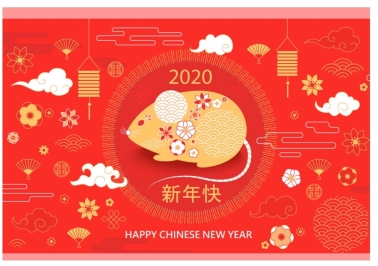Позакласний захід " Chinese New Year " для 5ого класу
Happy Chinese new year

Teacher : Kucahii Mariia
![]() China : The girl in the red dress
China : The girl in the red dress![]()
 Level: Pre-intermediate Class : 5th
Level: Pre-intermediate Class : 5th
Duration: Approx. 60 minutes
Aims: In this lesson![]() the students will:
the students will:
- learn about the Chinese New Year;
- practise extensive and intensive listening and a range of listening sub-skills, including listening for specific information and gist;
- complete a memory recall comprehension task to consolidate the story and new language;
- learn about their Chinese zodiac and their trades and character
- learn about dragon dance and make their own dragon of wealth
Materials: one copy of the worksheet per student; Track 1 (introduction); Track 2 (remaining audio) and Track 3 (full audio)
Summary: Join time traveller Amber Adams as she is transported to a village in China for New Year. Will Amber and travelling merchant Hongjun be able to save the villagers from Nian, the evil monster who steals children?
Procedure
Warmer
Aim: to introduce students to the character of Amber, the secret watch and the context of the episode
1. Play Track 1 (introduction). At this stage students simply listen for enjoyment. They don’t need to write anything down.
2. After listening to the introduction, whole discussion class:
- What story is being told?
- Who is Nian?
- Who is Amber Adams?
Chinese New Year task
Aim: to introduce students to the theme of the Chinese New Year
1. Write Chinese New Year on the board and find out what students already know about it. They may know about the traditional lion/dragon dance or the giving of money in red envelopes.
2. Put students into pairs or small groups and hand out the worksheet. Ask students to read the excerpt taken from China and answer the questions below it.
Reading task
Read the following excerpt about the Chinese New Year and answer the questions below it.
Spring Festival (Chun Jie) – Chinese New Year
This is the most important Chinese festival and celebrates the end of winter and the beginning of spring. The exact day depends on the date of the new moon, but it is always between 21st January and 19th February. The festival lasts fifteen days and tens of millions of Chinese people travel to their hometowns to be with their families.
In the days before New Year, people clean their homes. Duilian – long pieces of red paper with short poems in beautiful calligraphy on them – are put on both sides of the door and everyone buys new clothes. On the evening before New Year’s Day, the family gets together in the evening for a big meal.
Jiaozi dumplings, noodles, chicken and fish are all traditional New Year foods. After dinner, hongbao, red envelopes containing money, are given to children. At midnight the bells ring and the celebrations start with fireworks.
A traditional lion dance, which is thought to bring good luck, is often performed at New Year. Two dancers – one for the lion’s head and the other for the body – dance through the streets to
loud music.
1. When is the Chinese New Year?
2. How long does the celebration last?
3. What do people do in the days before New Year?
4. What foods are traditional?
5. What dance is performed and why?
Vocabulary task
Aim: to pre-teach a range of more complex language taken from the listening passage
Direct your students to the vocabulary task on the worksheet and ask them to match the words to their definitions. Key: 1. ghost; 2. shiver; 3. merchant; 4. barn; 5. shadow; 6. crunch; 7. roar; 8. monster;
9. legend; 10. hero
Language Task
Match the words to the definitions.
 . shadow monster hero ghost barn shiver (v) merchant legend roar (n) crunch (v)
. shadow monster hero ghost barn shiver (v) merchant legend roar (n) crunch (v)
- A ___________________ is the spirit of a dead person that somebody sees.
- If your body shakes because you are cold or frightened, you ___________________.
- A ____________________ is an old word for someone who buys and sells goods.
- A ____________________ is a large building (normally on farm) where animals and machines are kept.
- A ____________________ is an area of darkness created when something blocks light.
- To ___________________ is to bite something hard causing it to make a loud noise.
- A ____________________ is a loud deep sound that lions often make.
- A ____________________ is an imaginary creature that is large and frightening.
- A ____________________ is an old story about famous people and events in the past. Legends are not usually true.
- Someone who has done something brave, for example saving a person’s life or risking their own life, is called a _______________________.
Listening task
Aim: to practise listening for gist
1. Direct students to the listening task on the worksheet and explain that they need to listen for the answers to the questions. 2. Play Track 2 (remaining audio).
Listening task
Listen to the story and answer the questions below.
- Why do Amber and Hongjun go to look for Nian?
- What do they discover Nian is scared of?
Key: 1. because a child called Yang has been taken by Nian; 2. the colour red
Memory task
Aim: to allow students to fully consolidate what they have heard
Put students into small groups and ask them to work together to see how much of the story they can remember.
Memory task
In small groups, discuss the questions below. How much can you remember?
- Why is Amber in China?
- Why does the villager take Amber inside?
- What is Hongjun’s job?
- What does Amber buy from Hongjun?
- At the party what happens to a small boy called Yang?
- Where does Nian live?
- What does Hongjun ask Nian?
- What did Nian see as the sun shone through a crack in the cave’s roof?
- When they return to the village, what does Amber tell the people?
- After this event, what did villagers begin do before New Year’s day?
Key:
-
She’s doing a school project about the Chinese New Year.
2. She’s scared that Nian will come as it is the first day of the new year.
3. He’s a travelling merchant.
4. a red dress
5. He is taken away by Nian.
6. He lives in a cave up in the mountains.
7. He asks Nian to stop attacking the villagers and free Yang.
8. Amber’s red dress
9. Nian is very scared of the colour red.
10. They placed red paper on their doors.
Speaking task
- Tell students that each new year is associated with one of twelve animals, called Chinese zodiac animals. The twelve zodiac animals are the dragon, tiger, horse, rat, cow, rabbit, snake, goat, monkey, rooster, dog, and pig.
- Explain to students that in the Chinese tradition, you are said to have the same personality traits as the zodiac animal from the year you were born.
- Tell students that because they are all close in age, their class will only have two, possibly three, zodiac animals represented:
- Tell students that the dragon represents wisdom, power and wealth. Its believed that performing the dragon dance scares away evil spirits and all the bad luck associated with them, and bring good luck and wealth instead.
- Make the dragon as a symbol of the class, pupils’ wealth and luck in 2020.

Review and closing
- Show students your completed Chinese New Year Good Fortune Printable worksheet.
- Explain to students that the Chinese character on this sign says, "Fu" which means good fortune, or luck.
- Invite the students to make/ finish their own signs .
- Explain to students that they can give


про публікацію авторської розробки
Додати розробку
